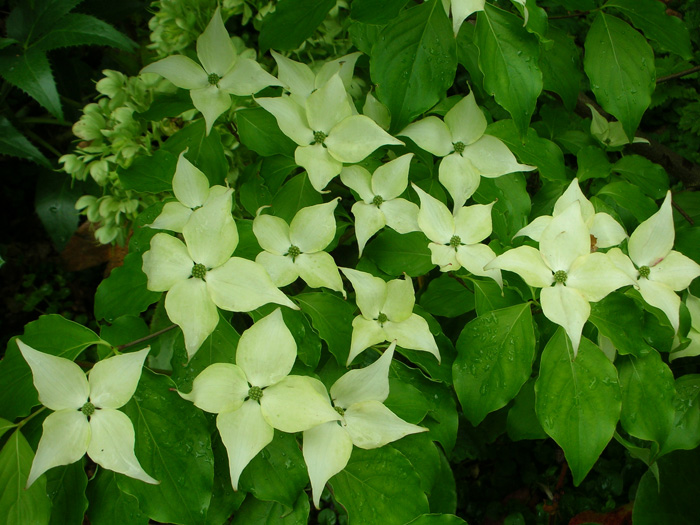 One of the nicest things you can give to mark a special occasion is a plant which will ‘do it’s thing’ at the time of the event each year.
One of the nicest things you can give to mark a special occasion is a plant which will ‘do it’s thing’ at the time of the event each year.
There is a chance that you already have a plant in your garden that has a special significance; perhaps a cutting taken from Granny’s garden, a plant bought on a holiday or a gift from a friend. It is a plant with a particular memory for you.
In our garden we have several such special favourites.
My husband was bought a Cornus kousa var chinensis for his 50th birthday by his mother that we kept in a pot on the patio for a while. The pot cracked a couple of winters ago so the lucky Cornus was put in the ground and has enjoyed its new home.
It is a large and elegant shrub or small tree from Japan and Korea, worthy of a place on its own where it can be admired and allowed to grow slowly to its full size. The branches are open and spreading and are covered in early summer with slender-stalked flower heads of showy white bracts, which later produce strawberry-like fruits in a good year. The foliage catches fire in autumn, turning rich bronze, orange and crimson. A beautiful shrub that grows slowly at first, but eventually needs plenty of room. The Royal Horticultural Society has given it its prestigious Award of Garden Merit (AGM).
We have a vine, another family birthday gift, which turns the most fantastic colour at this time of year. The grapes are not quite ripe yet but last year they were an excellent handful in October. As I type the name I see it is Vitis Brant – just one letter short of Bryant – I have never noticed that before!
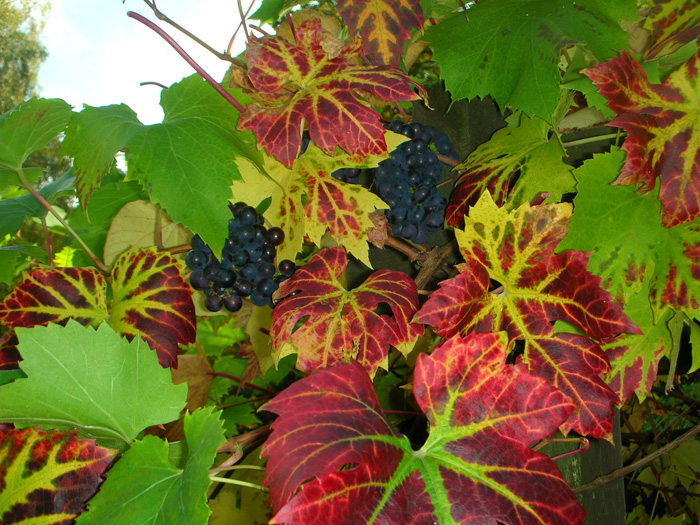
Vitis Brant
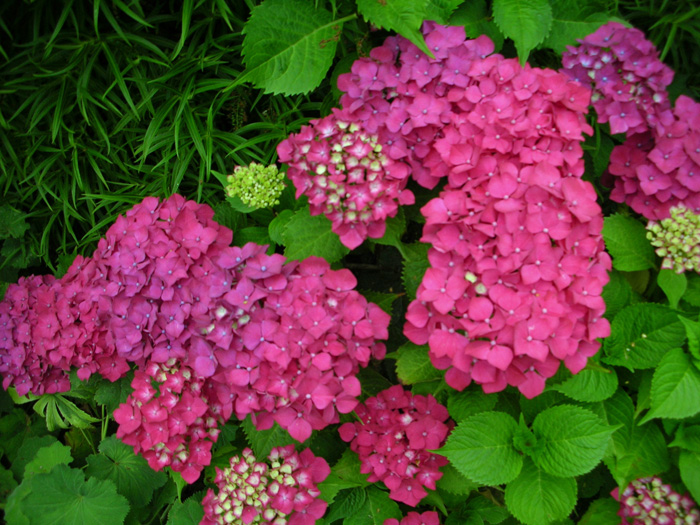 We have a lovely pink Hydrangea, bought by a dear friend to remember my Mum when she died, and this year it has been beautiful. Hydrangeas are interesting plants because they change colour according to the pH of the soil which affects aluminium availability. Those with blue or pink flowers tend to be blue in acid soil conditions mauve in acid to neutral soil conditions, and pink in alkaline conditions. To get the best flower colour, choose cultivars that give the best colours for the pH in question.
We have a lovely pink Hydrangea, bought by a dear friend to remember my Mum when she died, and this year it has been beautiful. Hydrangeas are interesting plants because they change colour according to the pH of the soil which affects aluminium availability. Those with blue or pink flowers tend to be blue in acid soil conditions mauve in acid to neutral soil conditions, and pink in alkaline conditions. To get the best flower colour, choose cultivars that give the best colours for the pH in question.
White flowers, and also green-flowered cultivars, remain white or green regardless of soil pH.
Try to use rainwater to water hydrangeas, since mains hard water can affect the flower colour, turning blue flowers mauve or pink.
This Hydrangea defies the rules – we have acid soil but it remains a strong pink colour – oh well, I suppose my Mum was a redhead!
Hydrangea macrophylla
Garden centres usually have ‘plant of the month’ areas where seasonal specials are displayed but a few suggestions are
January Chaenomoles japonica, flowering quince
February Hamamelis, Witch hazel - scented
March Viburnum burckwoodii – scented
April Magnolia stellata – fabulous white flowers
May Syringa, Lilac - try the dwarf Syringa palibin – scented
June Philadelphus or roses – scented
July Trachelospermum jasminoides – scented evergreen climber
August Abelia x grandiflora – scented, evergreen
September Hydrangeas
October Acer, Japanese maple
November Viburnum x bodnantense Dawn – scented all winter
December Prunus subhirtella ‘Autumnalis’ – small tree
Long time friends of ours recently celebrated their fortieth wedding anniversary in January, not the easiest time of the year for plant material, but our gift for them was a Japanese maple, Acer Sango-kaku, which has bright coral bark through the winter – perfect to mark their Ruby anniversary. Other red winter barked plants are the Cornus varieties or for early red flower colour there are Camellias. The photo below was taken in March and you can see the Camellia Adolphe Audusson in flower behind.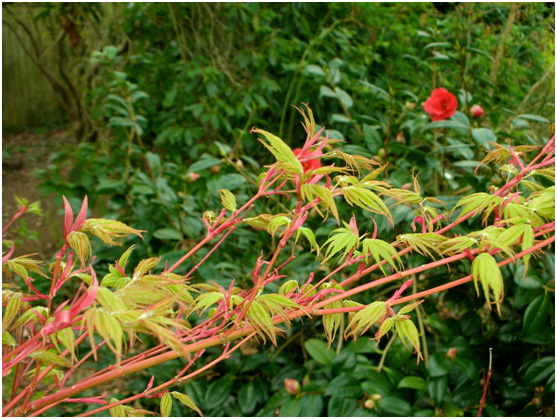
New spring growth on red barked stems Acer palmatum Sango-kaku
Tragically, these dear friends lost their brave soldier son this summer following an explosion in Afghanistan, and they gave us a beautiful ‘Help for Heroes’ Rose to remember him.
Hilliers launched the rich-red Help for Heroes rose in aid of the Help for Heroes charity. They donate £3 from the sale of each rose at www.hillier.co.uk directly to this excellent cause. The Help for Heroes rose bears a mass of fragrant clusters of deep red full-petalled flowers from late spring right through to the first frosts of winter. Ideal for large containers, mixed borders or low hedging, the Help for Heroes floribunda rose grows 80cm tall by 60cm wide and has a strong, bushy habit and glossy, disease-resistant leaves.
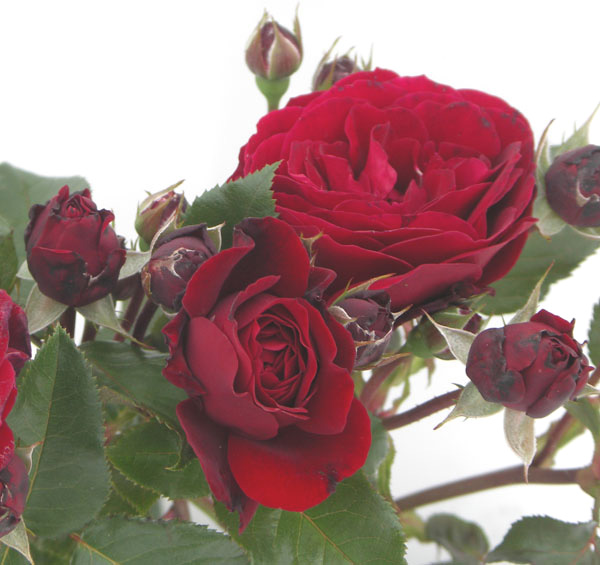
Help for Heroes Rose
Roses are good plants to use for creating scented summer ‘memories’. There are many named for special events such as Rosa Golden Wedding, Ruby Wedding, and The Bride, and many with other appropriate names Anthony, Belinda, Celine, Daphne etc. You could also give ‘Home sweet home’, ‘Congratulations’ or ‘Peace’ as appropriate!
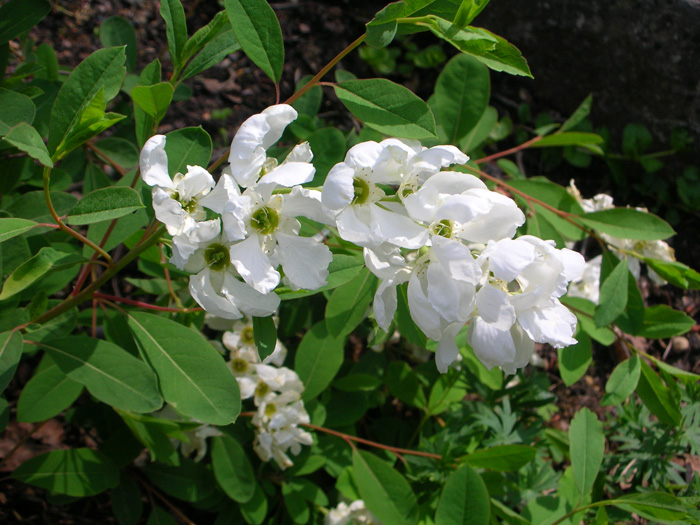 Exochorda x macrantha ‘The Bride’ is a lovely plant for a Spring wedding. When in flower, this deciduous shrub is just gorgeous. For about six weeks in April and May, its arching branches are wreathed in open white flowers that almost smother the soft, green foliage. In autumn the leaves turn delicate shades of yellow and orange. This shrub has been given the Award of Garden Merit by the Royal Horticultural Society and although it will take some shade, it flourishes best in a sunny, open position. It can also be trained as a wall shrub.
Exochorda x macrantha ‘The Bride’ is a lovely plant for a Spring wedding. When in flower, this deciduous shrub is just gorgeous. For about six weeks in April and May, its arching branches are wreathed in open white flowers that almost smother the soft, green foliage. In autumn the leaves turn delicate shades of yellow and orange. This shrub has been given the Award of Garden Merit by the Royal Horticultural Society and although it will take some shade, it flourishes best in a sunny, open position. It can also be trained as a wall shrub.
Exochorda x macrantha “The Bride’
We have been invited to celebrate with friends next weekend – they have their 50th birthdays and their daughters are 18 and 21 this year! I don’t think the girls will appreciate plants but I was thinking of perhaps 50 Camassia bulbs or a cloud pruned Ilex crenata with 5 pom-poms for the parents. I gave my sister a 6 pom-pom Ilex for her 60th (and bought myself one for my 50th!) I feel a trip to the nursery is needed for inspiration!
When planting gardens for clients I usually try to use a ‘special’ plant with a significant name. Recent clients granddaughter is called Rebecca and Viola Rebecca is a delight – scented, sun or part shade, long flowering, easy.
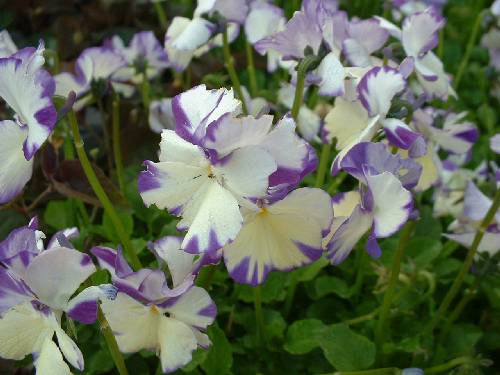
Viola Rebecca
Another client’s daughter was Charlotte and a good clump of Anemone japonica Queen Charlotte was a bright addition to a semi shaded border.
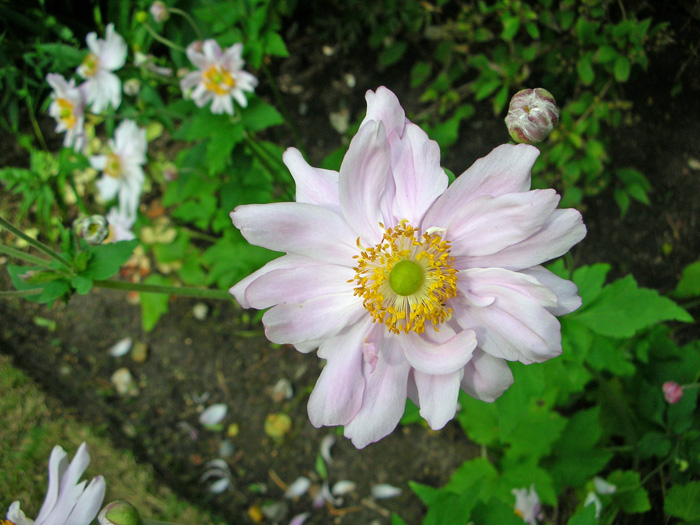
Anemone japonica “Queen Charlotte’
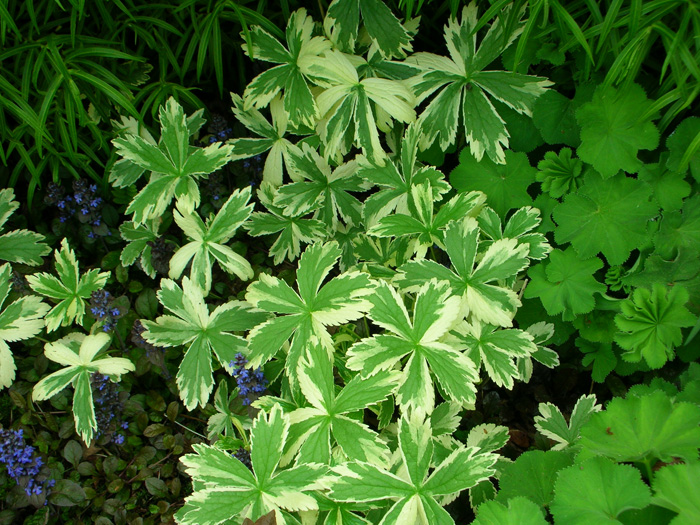 Astrantia ‘Sunningdale Variegated’ commemorates our local area.
Astrantia ‘Sunningdale Variegated’ commemorates our local area.
A. 'Sunningdale Variegated' has yellow markings of varying intensity on the leaves and is highly esteemed in connoisseur circles - and is correspondingly priced. It depends how much you like plants with variegated leaves and whether you have the right position - it will light up a corner where the shade is not too great. There is also an Astrantia ‘Ruby wedding’!
Astrantia ‘Sunningdale variegated’ in a shady border
For my niece’s 10th wedding anniversary and a move to new home this summer I bought them an Acer palmatum Bloodgood (there’s always a good excuse for an Acer!) Those of you who know me may smile because I can justify an Acer for every situation (and try to give most of my clients one!)
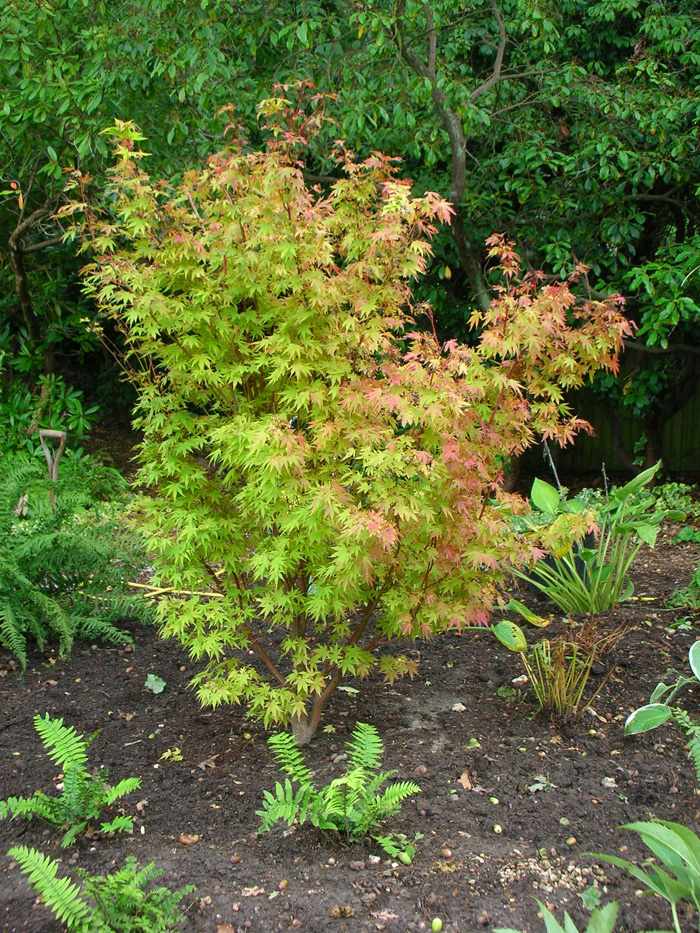
Acer Corallinum, ferns and Hostas
My lovely husband is 60 in a week or so and I have planted Acer Corallinum in an area I have cleared of old Rhododendron ponticum and Gaulteria and surrounded it with ferns and Hostas – a perfect place in the shade of the oaks.
May it live long and flourish!
Plants for special occasions
One of the nicest things you can give to mark a special occasion is a plant which will ‘do it’s thing’ at the time of the event each year. There is a chance that you already have a plant in your garden that has a special significance; perhaps a cutting taken from Granny’s garden, a plant bought on a holiday or a gift from a friend. It is a plant with a particular memory for you.
In our garden we have several such special favourites.
My husband was bought a Cornus kousa var chinensis for his 50th birthday by his mother that we kept in a pot on the patio for a while. The pot cracked a couple of winters ago so the lucky Cornus was put in the ground and has enjoyed its new home.
It is a large and elegant shrub or small tree from Japan and Korea, worthy of a place on its own where it can be admired and allowed to grow slowly to its full size. The branches are open and spreading and are covered in early summer with slender-stalked flower heads of showy white bracts, which later produce strawberry-like fruits in a good year. The foliage catches fire in autumn, turning rich bronze, orange and crimson. A beautiful shrub that grows slowly at first, but eventually needs plenty of room. The Royal Horticultural Society has given it its prestigious Award of Garden Merit (AGM).

Cornus kousa var chinensis
We have a vine, another family birthday gift, which turns the most fantastic colour at this time of year. The grapes are not quite ripe yet but last year they were an excellent handful in October. As I type the name I see it is Vitis Brant – just one letter short of Bryant – I have never noticed that before!

Vitis Brant
We have a lovely pink Hydrangea, bought by a dear friend to remember my Mum when she died, and this year it has been beautiful. Hydrangeas are interesting plants because they change colour according to the pH of the soil which affects aluminium availability. Those with blue or pink flowers tend to be blue in acid soil conditions mauve in acid to neutral soil conditions, and pink in alkaline conditions. To get the best flower colour, choose cultivars that give the best colours for the pH in question.
White flowers, and also green-flowered cultivars, remain white or green regardless of soil pH.
Try to use rainwater to water hydrangeas, since mains hard water can affect the flower colour, turning blue flowers mauve or pink.
This Hydrangea defies the rules – we have acid soil but it remains a strong pink colour – oh well, I suppose my Mum was a redhead!

Hydrangea macrophylla
Garden centres usually have ‘plant of the month’ areas where seasonal specials are displayed but a few suggestions are
January Chaenomoles japonica, flowering quince
February Hamamelis, Witch hazel - scented
March Viburnum burckwoodii – scented
April Magnolia stellata – fabulous white flowers
May Syringa, Lilac - try the dwarf Syringa palibin – scented
June Philadelphus or roses – scented
July Trachelospermum jasminoides – scented evergreen climber
August Abelia x grandiflora – scented, evergreen
September Hydrangeas
October Acer, Japanese maple
November Viburnum x bodnantense Dawn – scented all winter
December Prunus subhirtella ‘Autumnalis’ – small tree
Long time friends of ours recently celebrated their fortieth wedding anniversary in January, not the easiest time of the year for plant material, but our gift for them was a Japanese maple, Acer Sango-kaku, which has bright coral bark through the winter – perfect to mark their Ruby anniversary. Other red winter barked plants are the Cornus varieties or for early red flower colour there are Camellias. The photo below was taken in March and you can see the Camellia Adolphe Audusson in flower behind.

New spring growth on red barked stems Acer palmatum Sango-kaku
Tragically, these dear friends lost their brave soldier son this summer following an explosion in Afghanistan, and they gave us a beautiful ‘Help for Heroes’ Rose to remember him.
Hilliers launched the rich-red Help for Heroes rose in aid of the Help for Heroes charity. They donate £3 from the sale of each rose at www.hillier.co.uk directly to this excellent cause. The Help for Heroes rose bears a mass of fragrant clusters of deep red full-petalled flowers from late spring right through to the first frosts of winter. Ideal for large containers, mixed borders or low hedging, the Help for Heroes floribunda rose grows 80cm tall by 60cm wide and has a strong, bushy habit and glossy, disease-resistant leaves.

Help for Heroes Rose
Roses are good plants to use for creating scented summer ‘memories’. There are many named for special events such as Rosa Golden Wedding, Ruby Wedding, and The Bride, and many with other appropriate names Anthony, Belinda, Celine, Daphne etc. You could also give ‘Home sweet home’, ‘Congratulations’ or ‘Peace’ as appropriate!
Exochorda x macrantha ‘The Bride’ is a lovely plant for a Spring wedding. When in flower, this deciduous shrub is just gorgeous. For about six weeks in April and May, its arching branches are wreathed in open white flowers that almost smother the soft, green foliage. In autumn the leaves turn delicate shades of yellow and orange. This shrub has been given the Award of Garden Merit by the Royal Horticultural Society and although it will take some shade, it flourishes best in a sunny, open position. It can also be trained as a wall shrub.

Exochorda x macrantha “The Bride’
We have been invited to celebrate with friends next weekend – they have their 50th birthdays and their daughters are 18 and 21 this year! I don’t think the girls will appreciate plants but I was thinking of perhaps 50 Camassia bulbs or a cloud pruned Ilex crenata with 5 pom-poms for the parents. I gave my sister a 6 pom-pom Ilex for her 60th (and bought myself one for my 50th!) I feel a trip to the nursery is needed for inspiration!
When planting gardens for clients I usually try to use a ‘special’ plant with a significant name. Recent clients granddaughter is called Rebecca and Viola Rebecca is a delight – scented, sun or part shade, long flowering, easy.

Viola Rebecca
Another client’s daughter was Charlotte and a good clump of Anemone japonica Queen Charlotte was a bright addition to a semi shaded border.

Anemone japonica “Queen Charlotte’
Astrantia ‘Sunningdale Variegated’ commemorates our local area.
A. 'Sunningdale Variegated' has yellow markings of varying intensity on the leaves and is highly esteemed in connoisseur circles - and is correspondingly priced. It depends how much you like plants with variegated leaves and whether you have the right position - it will light up a corner where the shade is not too great. There is also an Astrantia ‘Ruby wedding’!

Astrantia ‘Sunningdale variegated’ in a shady border
For my niece’s 10th wedding anniversary and a move to new home this summer I bought them an Acer palmatum Bloodgood (there’s always a good excuse for an Acer!) Those of you who know me may smile because I can justify an Acer for every situation (and try to give most of my clients one!)

Acer Corallinum, ferns and Hostas
My lovely husband is 60 in a week or so and I have planted Acer Corallinum in an area I have cleared of old Rhododendron ponticum and Gaulteria and surrounded it with ferns and Hostas – a perfect place in the shade of the oaks.
May it live long and flourish!
